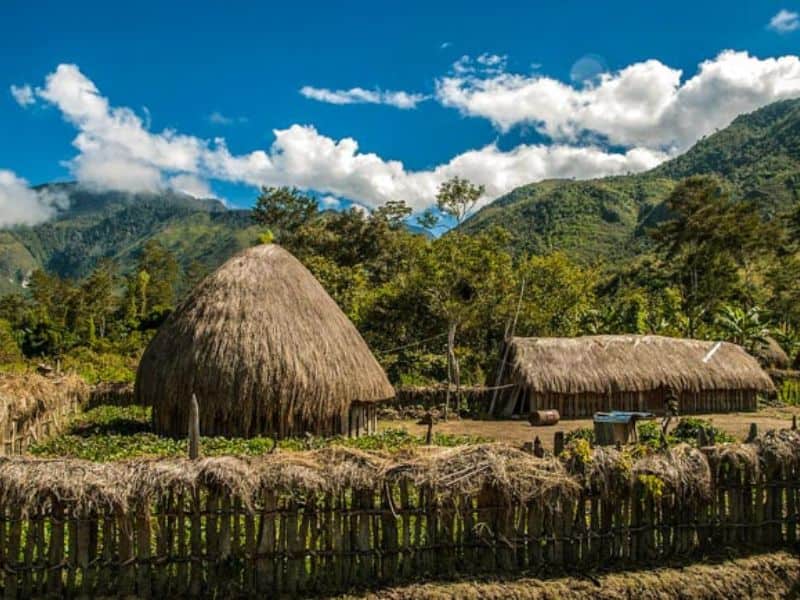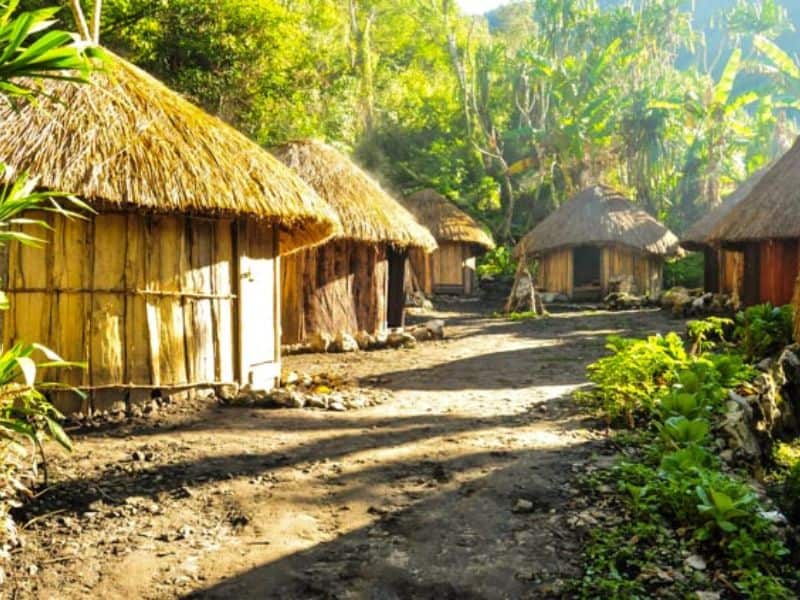Traditional Papuan houses have a unique history and culture, Travela can make your holiday moments unforgettable.
Traditional Papuan Traditional House – A trip to a place will certainly be more memorable and meaningful if Travela visits a traditional house. Likewise, the traditional Papuan house is not just a physical structure, but a work of architectural art with deep cultural and philosophical implications.
Each traditional house has its own characteristics, expressing philosophical beliefs and functions that are often associated with the daily lives of its people.
Before continuing, first we must understand better about traditional Papuan traditional houses. Understand the historical context, building structure, and the values embedded in it. Allows us to appreciate the rich and deep cultural history of the Papuan tribes.
This deeper understanding allows us to better appreciate the uniqueness and complexity of culture which is an extraordinary asset for the Indonesian nation.
About Papuan Traditional Houses
Travela, Papuan traditional house as a symbol of Indonesian cultural diversity, reflects the uniqueness and strength of local culture.
So, this traditional house is made from natural materials such as wood and bamboo, has a high curved roof that resembles an upside down boat or Mythological animals.
Traditional Papuan houses not only function as a place to live, but are the center of social, cultural and spiritual activities of the Papuan people.
Traditional Papuan dwellings that have been passed down from generation to generation represent a strong cultural identity and must be protected.
Also read later:
The Attraction of Traditional Houses in Papua
The traditional Papuan house functions as a center for social, cultural and spiritual activities as well as a place to live. Apart from being a place for family gatherings, Papuan houses are often used for important meetings, traditional ceremonies and religious activities such as weddings and funerals.
This allows Community members to Interact, thereby increasing Solidarity and a sense of Togetherness. Thus, traditional Papuan houses have become an important symbol of cultural identity and are preserved by the Papuan people.
Traditional Papuan Houses are interesting because of their unique buildings and cultural symbolism. Traditional Papuan houses have a unique shape, resembling an inverted boat with a curved roof that rises high and are made from natural materials such as wood, leaves and stone.
Apart from that, the beauty of the traditional carvings and ornaments that decorate the walls and doors of traditional Papuan houses also adds to their visual appeal.
Traditional Papuan houses have distinctive characteristics that represent the culture and lifestyle of native Papuan people. One of its characteristic features is its high and stilt housing. This residence is built on long poles driven into the ground, its height can reach more than 10 meters.
This tall building structure not only protects against attacks by wild animals and floods. However it allows efficient air circulation under the house, which is important considering the humid tropical climate in Papua.
Apart from that, traditional Papuan houses are famous for having roofs made from thatch leaves or Alang-alang which are collected and tied traditionally.
The roof slopes down until it almost touches the ground, giving an aesthetic appearance and different from traditional residences in other areas.
This roof not only protects the house from rain and sunlight, but allows natural air circulation inside. The walls of houses in various regions of Papua are made from woven bamboo or other natural materials, giving the house a different look and a permanent look.
Following are the types
1. House of Millipedes
Travela, a traditional Papuan traditional house, is used by the community Dani tribe. The aim behind this house is to foster a close relationship between humans and nature.
Its characteristic is a wooden building with a roof made of thatch or woven leaves. The Thousand Feet House functions as a residence as well as a venue for various traditional and social events.
2. Hunila House
Hunila's residence is usually located in the interior of Papua. The goal behind this house is to achieve harmony between humans and nature.
Its characteristic is a wooden construction with a roof made of thatch or woven leaves. Hunila House functions as a home as well as a place to gather and celebrate traditional ceremonies.
3. Ebei House
Travela, Ebei House is generally seen in the Papuan highlands. The aim behind this traditional Papuan traditional house is to foster a peaceful relationship between humans and nature.

Typical features are wooden and bamboo houses with thatched or woven leaf roofs. The Ebei House functions as a residence and storage facility for agricultural products and household equipment.
4. Jew House
Travela, the Jew House, is a traditional Papuan house usually inhabited by tribes along the Papuan coastline. The purpose behind this house is to Illustrate the People's strong contact with the sea and other natural resources.
Jew houses are distinguished by their use of cut and layered wood, and their downward sloping roofs. The Jew House functions as a residence as well as a storage place for fishing equipment and marine catches.
5. Kariwari House
Travela, Kariwari is commonly used by tribes in mountainous areas. The aim behind this house is to provide a sense of security and peace in the midst of an unfriendly natural atmosphere.
The structure of the house is made of wood and bamboo, with a thatched or woven leaf roof. The Kariwari House functions as a house and warehouse to protect it from rain and dangerous animals at night.
6. Honai House
Travela Honai is a traditional Papuan traditional house which is quite common in Papua. This house has a dome-like design and a high, round roof.

The purpose of this design is to Express a sense of Connectedness and Unity of the People of Papua New Guinea. The Honai House is characterized by a thatched or leaf roof that is tightly closed, resembling a dome, providing excellent protection from bad weather.
Honai functions as a home and gathering place for families or groups in Papuan villages.
7. Wamai House
Travela, Wamai is the traditional house of the Asmat tribe in Papua. The aim behind this traditional Papuan traditional house is to foster a sense of togetherness and solidarity among its residents.
Its characteristic is a wooden building with a roof made of thatch or woven leaves. The Wamai House functions as a residence as well as a place for social gatherings and traditional events.
Let's read other interesting information:
8. Rumsram House
Travela, Rumsram House is inhabited by tribes originating from the coastal region of Papua. The purpose behind this traditional Papuan house is to represent the intertwined life between humans, the sea and mangrove trees.
Its characteristic is a wooden building with a roof made of thatch or woven leaves. The Rumsram House functions as a residence as well as a place to store fishing tools and equipment.
If Travela is captivated by the rich culture and natural beauty of Papua, now is the time to visit this city! From beautiful forests to unique traditional houses, Papua offers unforgettable experiences.
So, which traditional Papuan traditional house do you want to visit? For now, write it down on your bucket list first, guaranteed you won't regret it!



